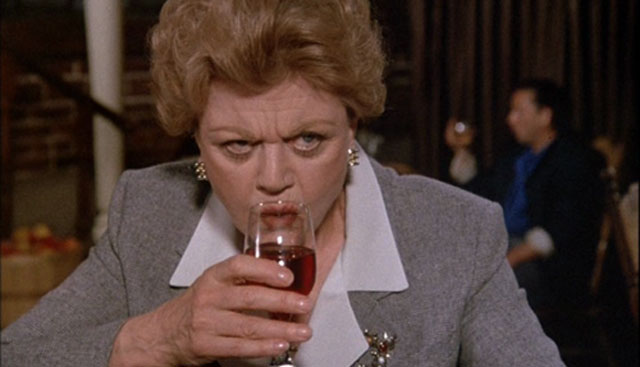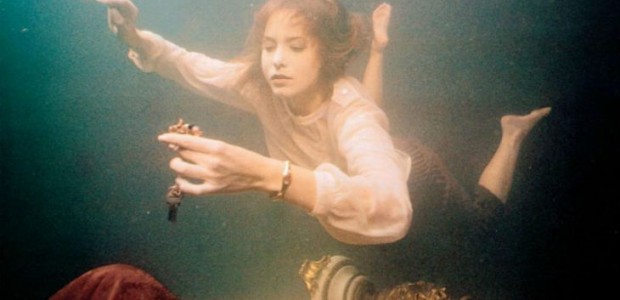
So Daily Grindhouse is doing a week on giallo movies. Editor-in-chief Jon Abrams gets ahold of me and asks if I’d like to write something. “Eh, it’s not really my favorite subgenre,” I demur, while in my head I’m dodging bullets like Neo and congratulating myself. “That’s okay,” Jon counters, “write about why you don’t like ’em!”
Clever guy, that Jon.

So… stop me if you’ve heard this before. The term giallo can be traced back to 1940s Italy, when a popular series of mystery paperbacks whose lurid covers were always set against a yellow background began to be published; giallo being Italian for yellow. Now if you’re Italian, any thriller is considered a giallo. They feel Alfred Hitchcock made gialli, even the fairly tame FAMILY PLOT. Mickey Spillane wrote gialli. MURDER SHE WROTE? Giallo.

It’s when you start moving west and into the English-speaking climes that giallo gains a much more specific definition. It’s a murder mystery, yes, and the murders tend to be hyper-violent, somewhat outlandish, and extremely gory. Black leather gloves are the official uniform of the giallo killer, and the murders are frequently shot from that killer’s POV, not only handily concealing said killer’s identity, but also adding to the voyeurism of the viewer, making them even more complicit in the act. The protagonist is never a policeman of any sort, but is some everyman, often a foreigner, who had the misfortune to witness the opening murder. And more often than not, that victim is a woman.

Gialli often have the charge of misogyny leveled against them, and frankly, it’s hard to make a case for their defense. These movies rose up in the late 60s and especially the 70s, as older production codes loosened, and the blood and violence are in competition with eroticism for screen time. The mixture of the two has always been a dependable shortcut to shock and discomfort, and giallo movies are not afraid to play that card.Sometimes it seems like they have a whole deck just made up of that card.

The most experience I’ve had with the subgenre is through the movies of Dario Argento, who screamed onto the scene with THE BIRD WITH THE CRYSTAL PLUMAGE in 1970 – in fact, the sole giallo I own is his 1971 follow-up, THE CAT O’NINE TAILS. Argento is singular among directors, as his murder scenes genuinely unnerve me. This is good, because, honestly, I should be repulsed and horrified by murder, but I watch a dozen cinematic murders a week without blinking. Argento is somehow able to make me forget everything I know about camera angles and makeup effects; it’s like I’ve never seen a movie before, and all that stuff is real.

That is another reason why I seem to be willing to come back to this particular charnel flavor upon occasion: the gialli directors were often daringly innovative in camera moves, lighting, color, music. But my major problem with their movies still remains the major problem I have with slasher movies: they’re pretty damn mechanical,and can get brutally misogynistic, often without seemingly trying.

Slasher movies aren’t really gialli (unless you’re Italian). A giallo is a murder mystery at its heart, and slasher movies are about that most American of pastimes, mass murder. Both have linchpin movies authored by yet another Italian giant of the screen, Mario Bava. BAY OF BLOOD has indiscriminate slaughter as unwary travelers wander into the killer’s sphere of influence (the first couple of FRIDAY THE 13th movies borrow from it), BLOOD AND BLACK LACE has likely the first instance of a black-gloved killer knifing his way through a house full of models to find the diary that could implicate him in the first murder. (If you need to find something concerning my hypocrisy, it’s that I’m very excited that the latter movie is making its Blu-Ray debut next month. It’s Bava. It’s seminal.)

Craig Ledbetter, in his late lamented European Trash Cinema magazine, devoted an entire issue to gialli, and seemingly tracked down and watched every goddamn one ever made. I asked him how the hell he managed that without going insane with boredom (in fact he seemed to tackle each instance of repetition with the same enthusiasm as the first), and he replied, basically, “I dunno. I guess I just love ’em.”

Well, I’m glad somebody does. I actually do hate to think about a whole subgenre that no one likes. That would be kind of sad. But gialli do not need me to survive and thrive, and if recent movies like THE STRANGE COLOR OF YOUR BODY’S TEARS and BERBERIAN SOUND STUDIO can get made and attract appreciative audiences, well… even an old grouch like me has to admit there must be something there, beyond pretty pictures and the swingin’ sounds of Goblin.
But I’m still going to leave it to its fans.

— FREEMAN WILLIAMS.

- [THE BIG QUESTION] WHAT’S YOUR FAVORITE FEMALE ENSEMBLE IN MOVIES? - July 22, 2016
- [IN THEATERS NOW] THE BOY (2016) - January 24, 2016
- Cult Movie Mania Releases Lucio Fulci Limited Edition VHS Sets - January 5, 2016
Tags: dario argento, Editorial, Freeman Williams, Giallo, Giallo Week, Goblin, mario bava






This is really a poor editorial all round. I get that you don’t like the work of Argento. Maybe you should have written about why you don’t like Argento giallo. You may even have seen a few others. But it seems to be that you are writing of a genre you have little, if any, understanding of. So why write about why you don’t like a genre about which you know almost nothing? Because all you have done is taken a few Argento (and possibly Bava) tropes and suggest that these are typical of giallo. They aren’t.
Giallo, which isn’t really a sub-genre at all, is a loose collection of thrillers in the spirit of the books you mention in the opening. Some have the characteristics you ascribe to gialli in general. Many more don’t. There are over a hundred of these films- some are house invasion films for example. These titles have no amateur sleuths, gloves, killer POV and so on. None have Goblin scores. Few have daringly innovative colour or lighting. Maybe you are thinking of Suspiria- but there is still an ongoing debate about whether Suspiria can be considered a giallo at all. Most fans suggest it isn’t. For what it is worth, incidentally, I take the view that Suspiria could be considered as part of the giallo filone, but admit that this is a view that many don’t share.
Anyhow I am feeling a little generous today so here is a diverse list for you to check out.
Orgasmo, Footprints (on the moon), Don’t Torture The Duckling, House With Laughing Windows, House With Yellow Carpet, Coplkiller (with John Lydon!!), The Killer Must Kill Again, Perversion Story. None of these fit into the strawman giallo you have constructed. Maybe give these a look. They may not still like giallo, that’d be fair enough. But you would then have a better understanding of how diverse the whole area of film is. You could then maybe re-read this editorial and cringe a little.
Thank you for the constructive elements of this comment, but as to the negative elements, please recall the opening lines of the piece. Freeman, a film enthusiast who knows plenty about many genres, was asked to write this editorial precisely because it’s a genre he is admittedly less enthused about, and did so in a friendly spirit. So thanks for reading — and for that list of recommendations — but it’s okay to lighten up a bit. — ED.
The negative elements (your words) are supposed to be the spirited defence of giallo bit. That was supposed to be my constructive bit. I do write a bit formally but it was meant to be helpful. The tone was meant to come across as peppered with faux outrage but there isn’t really a smiley for that. I AM NOT ANGRY. We cool? Anyhow…
You see as far as I am concerned it is okay to not like giallo, its okay to not like Argento. My point is that the editorial sets out to give a reason why the author dislikes giallo. But that maybe the author should maybe try some films that aren’t Argento. Because while he is very much the poster child of the filone there are others who approach all this in very different ways. Its a bit like saying I don’t like Hitchcock and then going on about birds all the time. Or I don’t like vampires cos of Dracula AD 72. etc..
If a friend were to say to you that they didn’t like action films and they had seen Champion the Wonder Horse and The Amazing Mr No Legs, to pick random examples then you may say why not try Vanishing Point and The Emperor Of The North. For example. My post is meant to be constructive in this spirit.
The list wasn’t really meant as recommendations as such- they were examples of giallo that do not in any way resemble what the piece claims to be giallo. Others would be Spider Labyrinth, The Killer Must Kill Again, Cold Eyes of Fear, The Girl Who Knew Too Much, The Embalmer…
Lenzi also directed several giallo that strayed miles from the whole blade, fedora and gloves stereotype. They are more traditional psychological thrillers.
Indeed trying to nail down giallo in terms of genre is a bit like trying to nail jelly (jello?) to the wall. It is better to think of filone in terms of a journey, begins with a film and concludes much later with a very different one. Each film being a little step on that journey. Argento has 4 or 5 steps on that journey, but there are hundreds. Many are pretty bad, cheap affairs that were hastily cobbled together to ride the wave (I’m looking at you Andrea Bianchi’s Massacro!). But there is real magic in there too.
Great article, and a good introduction on the genre. Thanks also for the links to “new” giallo/homage films, and other reviews.
I agree with you: even if a genre isn’t my cup of tea, I appreciate fandom and am usually interested in hearing what others adore about the works.